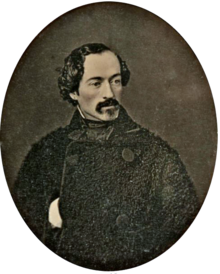Elisha Kane
| Elisha Kent Kane | |
|---|---|

Assistant Surgeon Elisha Kent Kane
|
|
| Born |
February 28, 1820 Philadelphia, Pennsylvania |
| Died | February 16, 1857 (aged 36) Havana, Cuba |
| Buried at | Laurel Hill Cemetery; Philadelphia, Pennsylvania (40°00′14″N 75°11′15″W / 40.003889°N 75.1875°WCoordinates: 40°00′14″N 75°11′15″W / 40.003889°N 75.1875°W) |
| Service/branch | United States Navy |
Elisha Kent Kane (February 28, 1820 – February 16, 1857) was an American explorer, and a medical officer in the United States Navy during the first half of the 19th century. He was a member of two Arctic expeditions to rescue the explorer Sir John Franklin. He was present at the discovery of Franklin's first winter camp, but he did not find out what had happened to the fatal expedition.
Born in Philadelphia, Pennsylvania, Kane was the son of John Kintzing Kane, a U.S. district judge, and Jane Duval Leiper. His brother was attorney, diplomat, abolitionist, and American Civil War general Thomas L. Kane. Kane graduated from the University of Pennsylvania Medical School in 1842. On September 14, 1843, he became Assistant Surgeon in the Navy. He served in the China Commercial Treaty mission under Caleb Cushing, in the Africa Squadron, and in the United States Marine Corps during the Mexican-American War. One battle that Kane fought in was at Nopalucan on January 6, 1848. At (sic) Napoluca, he captured, befriended and saved the life of Mexican General Antonio Gaona and the General's wounded son.
Kane was appointed senior medical officer of the Grinnell Arctic expedition of 1850–1851 under the command of Edwin de Haven, which searched unsuccessfully for the lost expedition of Sir John Franklin. During this expedition, the crew discovered Sir John Franklin's first winter camp. Kane then organized and headed the Second Grinnell expedition which sailed from New York on May 31, 1853, and wintered in Rensselaer Bay. Though suffering from scurvy, and at times near death, he pushed on and charted the coasts of Smith Sound and the Kane Basin, penetrating farther north than any other explorer had done up to that time. At Cape Constitution he discovered the ice-free Kennedy Channel, later followed by Isaac Israel Hayes, Charles Francis Hall, Augustus Greely, and Robert E. Peary in turn as they drove toward the North Pole.
...
Wikipedia
